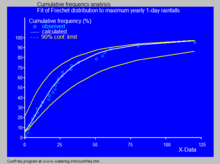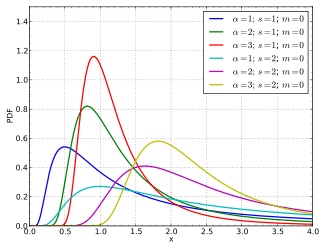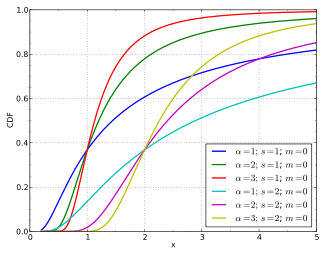Fréchet distribution
|
Probability density function
| |
|
Cumulative distribution function
| |
| Parameters |
shape. (Optionally, two more parameters) scale (default: ) location of minimum (default: ) |
|---|---|
| Support | |
| CDF | |
| Mean | |
| Median | |
| Mode | |
| Variance | |
| Skewness | |
| Ex. kurtosis | |
| Entropy | , where is the Euler–Mascheroni constant. |
| MGF | [1] Note: Moment exists if |
| CF | [1] |
The Fréchet distribution, also known as inverse Weibull distribution,[2][3] is a special case of the generalized extreme value distribution. It has the cumulative distribution function
where α > 0 is a shape parameter. It can be generalised to include a location parameter m (the minimum) and a scale parameter s > 0 with the cumulative distribution function
Named for Maurice Fréchet who wrote a related paper in 1927, further work was done by Fisher and Tippett in 1928 and by Gumbel in 1958.
Characteristics
The single parameter Fréchet with parameter has standardized moment
(with ) defined only for :
where is the Gamma function.
In particular:
- For the expectation is
- For the variance is
The quantile of order can be expressed through the inverse of the distribution,
- .
In particular the median is:
The mode of the distribution is
Especially for the 3-parameter Fréchet, the first quartile is and the third quartile
Also the quantiles for the mean and mode are:

Applications
- In hydrology, the Fréchet distribution is applied to extreme events such as annually maximum one-day rainfalls and river discharges.[4] The blue picture illustrates an example of fitting the Fréchet distribution to ranked annually maximum one-day rainfalls in Oman showing also the 90% confidence belt based on the binomial distribution. The cumulative frequencies of the rainfall data are represented by plotting positions as part of the cumulative frequency analysis. However, in most hydrological applications, the distribution fitting is via the generalized extreme value distribution as this avoids imposing the assumption that the distribution does not have a lower bound (as required by the Frechet distribution).
- One useful test to assess whether a multivariate distribution is asymptotically dependent or independent consists transforming the data into standard Frechet margins using transformation and then mapping from the cartesian to pseudo-polar coordinates . corresponds to the extreme data for which at least only one component is large while approximately 1 or 0 corresponds to only one component being extreme.
Related distributions
- If (Uniform distribution (continuous)) then
- If then
- If and then
- The cumulative distribution function of the Frechet distribution solves the maximum stability postulate equation
- If then its reciprocal is Weibull-distributed:
Properties
- The Frechet distribution is a max stable distribution
- The negative of a random variable having a Frechet distribution is a min stable distribution
See also
- Type-2 Gumbel distribution
- Fisher–Tippett–Gnedenko theorem
- CumFreq (application software for probability distributions including Fréchet)
References
- 1 2 Muraleedharan. G, C. Guedes Soares and Cláudia Lucas (2011). "Characteristic and Moment Generating Functions of Generalised Extreme Value Distribution (GEV)". In Linda. L. Wright (Ed.), Sea Level Rise, Coastal Engineering, Shorelines and Tides, Chapter 14, pp. 269–276. Nova Science Publishers. ISBN 978-1-61728-655-1
- ↑ Khan M.S.; Pasha G.R.; Pasha A.H. (February 2008). "Theoretical Analysis of Inverse Weibull Distribution" (PDF). WSEAS TRANSACTIONS on MATHEMATICS. 7 (2). pp. 30–38.
- ↑ de Gusmão, FelipeR.S. and Ortega, EdwinM.M. and Cordeiro, GaussM. (2011). "The generalized inverse Weibull distribution". Statistical Papers. 52 (3). Springer-Verlag. pp. 591–619. doi:10.1007/s00362-009-0271-3. ISSN 0932-5026.
- ↑ Coles, Stuart (2001). An Introduction to Statistical Modeling of Extreme Values,. Springer-Verlag. ISBN 1-85233-459-2.
Publications
- Fréchet, M., (1927). "Sur la loi de probabilité de l'écart maximum." Ann. Soc. Polon. Math. 6, 93.
- Fisher, R.A., Tippett, L.H.C., (1928). "Limiting forms of the frequency distribution of the largest and smallest member of a sample." Proc. Cambridge Philosophical Society 24:180–190.
- Gumbel, E.J. (1958). "Statistics of Extremes." Columbia University Press, New York.
- Kotz, S.; Nadarajah, S. (2000) Extreme value distributions: theory and applications, World Scientific. ISBN 1-86094-224-5
External links
- Bank of England working paper
- An application of a new extreme value distribution to air pollution data
- Wave Analysis for Fatigue and Oceanography

